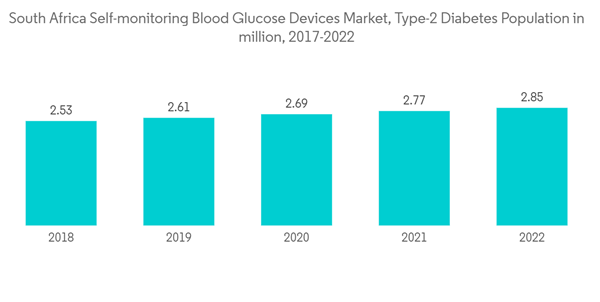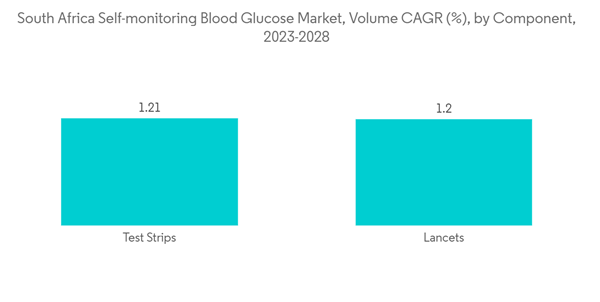The South Africa Self-monitoring Blood Glucose Devices Market size is estimated at USD 22.04 million in 2024, and is expected to reach USD 24.35 million by 2029, growing at a CAGR of 2.01% during the forecast period (2024-2029).
Patients with diabetes infected with COVID-19 experienced elevated blood glucose, abnormal glucose variability, and diabetic complications. The Western Cape Provincial Health Department's data on COVID-19 fatalities suggested that people with diabetes were more likely to die from COVID-19 than any other high-risk group. The provincial health department estimated that out of every 100 people within the public healthcare sector who died from COVID-19, 52 had diabetes. While new-onset hyperglycemia and new-onset diabetes were increasingly recognized in the context of COVID-19 and were associated with worse outcomes. To avoid aggravation, a patient's blood glucose should be monitored and maintained regularly, which has underlined the importance of diabetes care devices.
According to IDF Diabetes Atlas 2021, one in nine adults in South Africa were living with diabetes. The main diagnosis for diabetes patients was imbalances in blood glucose levels, which are not in compliance with the standard blood glucose levels. The general lab diagnostic tests can only help to diagnose the disease by physicians. Patients with more fluctuations in glucose levels need to get it checked every day. Patients taking insulin need to check their blood glucose levels frequently, adjust the doses of insulin, or change the medication if necessary.
The rate of newly diagnosed type 1 and type 2 diabetes cases is seen to increase, mainly due to obesity, unhealthy diet, and physical inactivity. The rapidly increasing incidence and prevalence of diabetic patients and healthcare expenditure in developed countries are indications of the increasing usage of diabetic care products. Self-blood glucose monitoring allows a patient to check their blood glucose levels as often as they need to or as recommended. Over time, the readings provide the patient and their health professionals with the information required to determine the best management strategy for diabetes. Leading manufacturers are focusing on technological innovations and the development of advanced products to gain a substantial share of the market.
According to IDF Diabetes Atlas 2021, one in nine adults in South Africa are living with diabetes. The diabetes prevalence in South Africa has reached 11.3%, the highest in Africa. The cost of diabetes-related health expenditure has risen to 1,700 USD per person, which is estimated to be around 7.2 billion USD. In South Africa, diabetes is the fastest-growing disease, and the country has a high number of diabetic patients. The prevalence of diabetes is growing among all ages in South Africa, which can be attributed to the increasingly obese population, along with an unhealthy diet and a sedentary lifestyle.
One of the most effective ways to decrease the prevalence of diabetes in South Africa is to educate citizens and encourage healthy decision-making. South Africa is currently working towards this goal. One recent preventative measure taken by the South African government is the implementation of a sugar tax. By charging more for sugary drinks and foods, the government is fighting obesity and helping citizens make more conscious decisions. South Africa launched a Diabetes Prevention Programme (DPP). The DPP aims to integrate intervention treatments for at-risk individuals.
Diabetes South Africa, Society for Endocrinology, Metabolism and Diabetes of South Africa, and Youth with Diabetes are the various organizations in South Africa working towards helping diabetes patients. The organizations are promoting the allocation of an increased budget dedicated to funding all aspects of diabetes care and providing a system for better coordination with the Council of Medical Schemes, the organization in charge of reimbursement, to limit out-of-pocket payments and prevent increased expenditure for patients. Pharmacologic therapy, such as oral medicines and insulin, as well as non-pharmacologic therapies, such as lifestyle changes, are modern approaches for diabetes management. These therapies are only possible through proper blood glucose monitoring and self-care.
Glucose monitoring gives people living with diabetes a more complete picture of their blood sugar levels, which can influence short- and long-term treatment decisions and improve health outcomes. It allows them and their healthcare providers to assess the glycemic status and adverse effects and to determine the effectiveness of glucose-lowering therapies. Glucose monitoring improves blood sugar management and quality of life for people living with diabetes, resulting in physical, social, emotional, and functional benefits. Self-monitoring of blood glucose is a way for people living with diabetes to measure and assess their glucose levels. It uses a drop of blood from a finger prick to get blood glucose readings using a blood glucose meter or glucometer.
A systematic approach to the organization of care is essential for diabetes, including well-trained and dedicated personnel, calibrated and functioning equipment, management and referral protocols, regular and sustainable supply of medication, syringes, and consumables, a register of all patients, and annual review charts. Various protocols such as the South Africa Diabetes Declaration Implementation Strategy, Long-term Care Model Implementation Plan, National Guideline: Non-Communicable Diseases: A Strategic Vision, Chronic Diseases Indicators, and Records with these updated guidelines facilitate improved quality of diabetes care.
Diabetes poses an emerging healthcare burden across the country and is one of the leading causes of premature death, morbidity, and loss of economic growth. Technological development is gaining momentum in the glucose monitoring market, which is likely to boost the adoption of these products in the market.
This product will be delivered within 2 business days.
Patients with diabetes infected with COVID-19 experienced elevated blood glucose, abnormal glucose variability, and diabetic complications. The Western Cape Provincial Health Department's data on COVID-19 fatalities suggested that people with diabetes were more likely to die from COVID-19 than any other high-risk group. The provincial health department estimated that out of every 100 people within the public healthcare sector who died from COVID-19, 52 had diabetes. While new-onset hyperglycemia and new-onset diabetes were increasingly recognized in the context of COVID-19 and were associated with worse outcomes. To avoid aggravation, a patient's blood glucose should be monitored and maintained regularly, which has underlined the importance of diabetes care devices.
According to IDF Diabetes Atlas 2021, one in nine adults in South Africa were living with diabetes. The main diagnosis for diabetes patients was imbalances in blood glucose levels, which are not in compliance with the standard blood glucose levels. The general lab diagnostic tests can only help to diagnose the disease by physicians. Patients with more fluctuations in glucose levels need to get it checked every day. Patients taking insulin need to check their blood glucose levels frequently, adjust the doses of insulin, or change the medication if necessary.
The rate of newly diagnosed type 1 and type 2 diabetes cases is seen to increase, mainly due to obesity, unhealthy diet, and physical inactivity. The rapidly increasing incidence and prevalence of diabetic patients and healthcare expenditure in developed countries are indications of the increasing usage of diabetic care products. Self-blood glucose monitoring allows a patient to check their blood glucose levels as often as they need to or as recommended. Over time, the readings provide the patient and their health professionals with the information required to determine the best management strategy for diabetes. Leading manufacturers are focusing on technological innovations and the development of advanced products to gain a substantial share of the market.
South Africa Self-monitoring Blood Glucose Devices Market Trends
Rising Diabetes Prevalence in South Africa is anticipated to boost the market studied
In South Africa, the diabetes population is expected to increase with a CAGR greater than 2.5% over the forecast period.According to IDF Diabetes Atlas 2021, one in nine adults in South Africa are living with diabetes. The diabetes prevalence in South Africa has reached 11.3%, the highest in Africa. The cost of diabetes-related health expenditure has risen to 1,700 USD per person, which is estimated to be around 7.2 billion USD. In South Africa, diabetes is the fastest-growing disease, and the country has a high number of diabetic patients. The prevalence of diabetes is growing among all ages in South Africa, which can be attributed to the increasingly obese population, along with an unhealthy diet and a sedentary lifestyle.
One of the most effective ways to decrease the prevalence of diabetes in South Africa is to educate citizens and encourage healthy decision-making. South Africa is currently working towards this goal. One recent preventative measure taken by the South African government is the implementation of a sugar tax. By charging more for sugary drinks and foods, the government is fighting obesity and helping citizens make more conscious decisions. South Africa launched a Diabetes Prevention Programme (DPP). The DPP aims to integrate intervention treatments for at-risk individuals.
Diabetes South Africa, Society for Endocrinology, Metabolism and Diabetes of South Africa, and Youth with Diabetes are the various organizations in South Africa working towards helping diabetes patients. The organizations are promoting the allocation of an increased budget dedicated to funding all aspects of diabetes care and providing a system for better coordination with the Council of Medical Schemes, the organization in charge of reimbursement, to limit out-of-pocket payments and prevent increased expenditure for patients. Pharmacologic therapy, such as oral medicines and insulin, as well as non-pharmacologic therapies, such as lifestyle changes, are modern approaches for diabetes management. These therapies are only possible through proper blood glucose monitoring and self-care.
The Glucometer Devices Segment is Expected to Witness the Highest CAGR Over the Forecast Period
The glucometers segment is expected to account for the highest CAGR of about 4% in the market over the forecast period owing to the increasing adoption of glucometers in home care settings, growing preference for home-based self-monitoring, and recent product launches of advanced glucometers.Glucose monitoring gives people living with diabetes a more complete picture of their blood sugar levels, which can influence short- and long-term treatment decisions and improve health outcomes. It allows them and their healthcare providers to assess the glycemic status and adverse effects and to determine the effectiveness of glucose-lowering therapies. Glucose monitoring improves blood sugar management and quality of life for people living with diabetes, resulting in physical, social, emotional, and functional benefits. Self-monitoring of blood glucose is a way for people living with diabetes to measure and assess their glucose levels. It uses a drop of blood from a finger prick to get blood glucose readings using a blood glucose meter or glucometer.
A systematic approach to the organization of care is essential for diabetes, including well-trained and dedicated personnel, calibrated and functioning equipment, management and referral protocols, regular and sustainable supply of medication, syringes, and consumables, a register of all patients, and annual review charts. Various protocols such as the South Africa Diabetes Declaration Implementation Strategy, Long-term Care Model Implementation Plan, National Guideline: Non-Communicable Diseases: A Strategic Vision, Chronic Diseases Indicators, and Records with these updated guidelines facilitate improved quality of diabetes care.
Diabetes poses an emerging healthcare burden across the country and is one of the leading causes of premature death, morbidity, and loss of economic growth. Technological development is gaining momentum in the glucose monitoring market, which is likely to boost the adoption of these products in the market.
South Africa Self-monitoring Blood Glucose Devices Industry Overview
The South Africa self-monitoring blood glucose devices market is moderately fragmented, with few significant and other generic players. Manufacturers like Abbott, F. Hoffmann-La Roche AG, Ascensia, etc. occupy a major share.Additional Benefits:
- The market estimate (ME) sheet in Excel format
- 3 months of analyst support
This product will be delivered within 2 business days.
Table of Contents
1 INTRODUCTION
4 MARKET DYNAMICS
5 MARKET SEGMENTATION
6 MARKET INDICATORS
7 COMPETITIVE LANDSCAPE
Methodology

LOADING...










